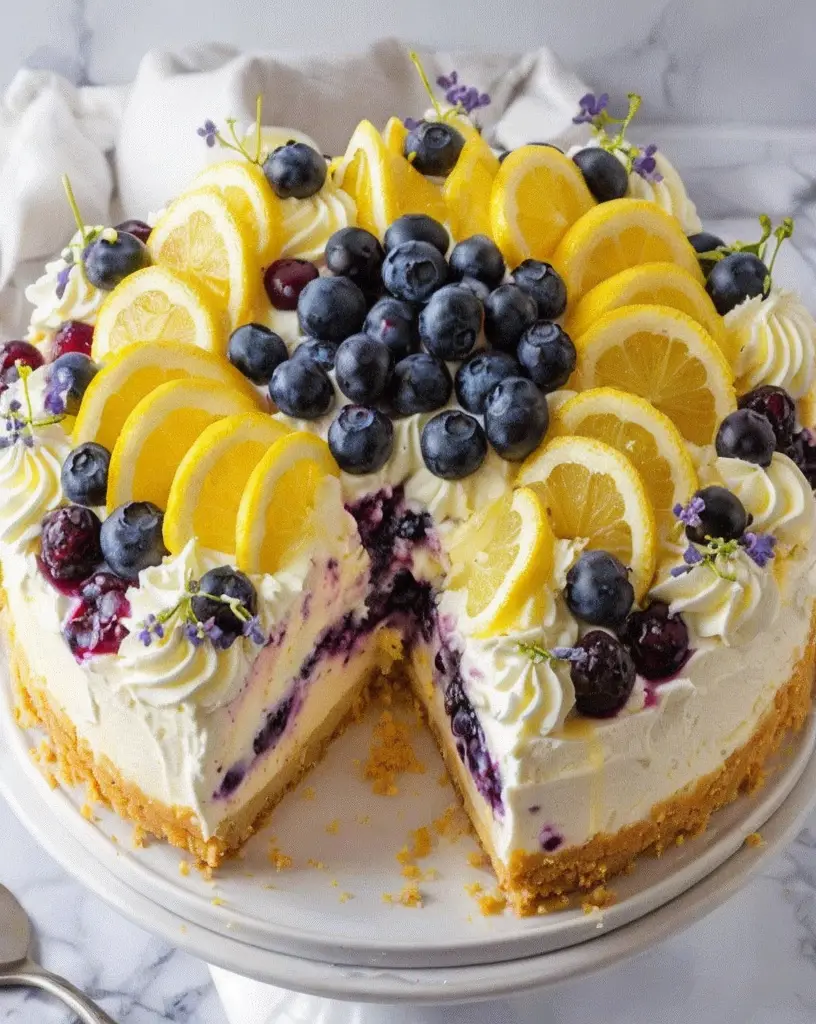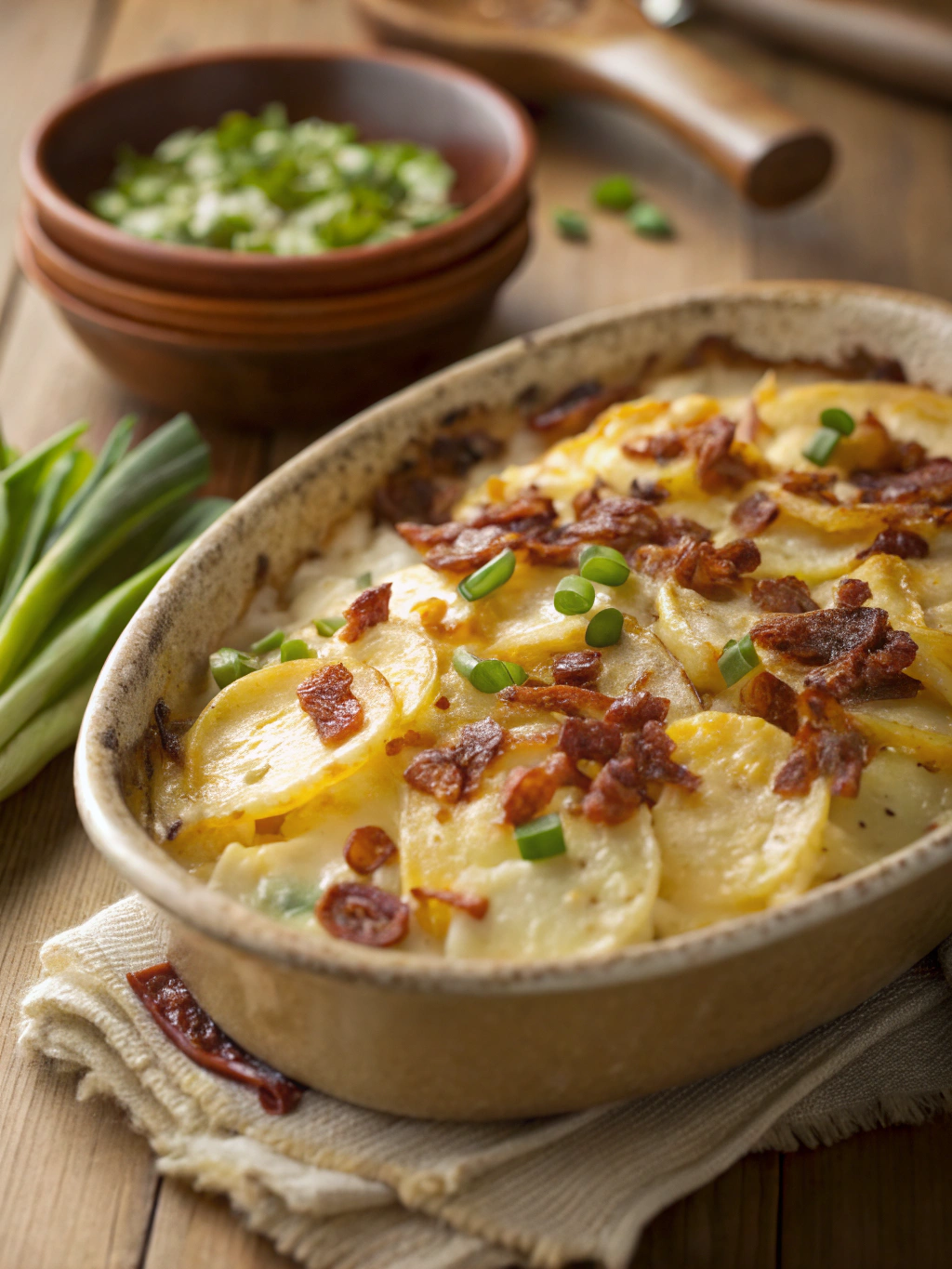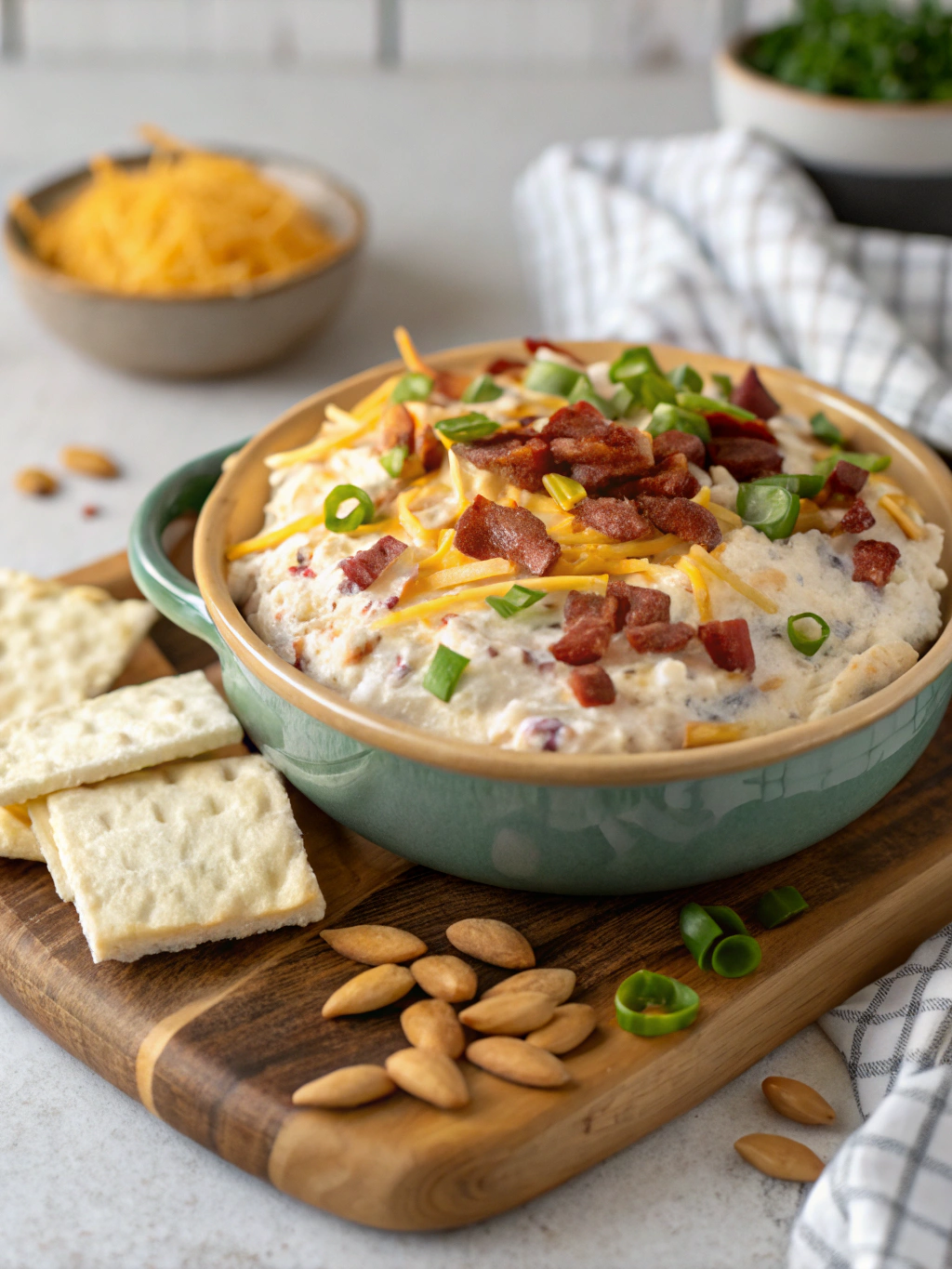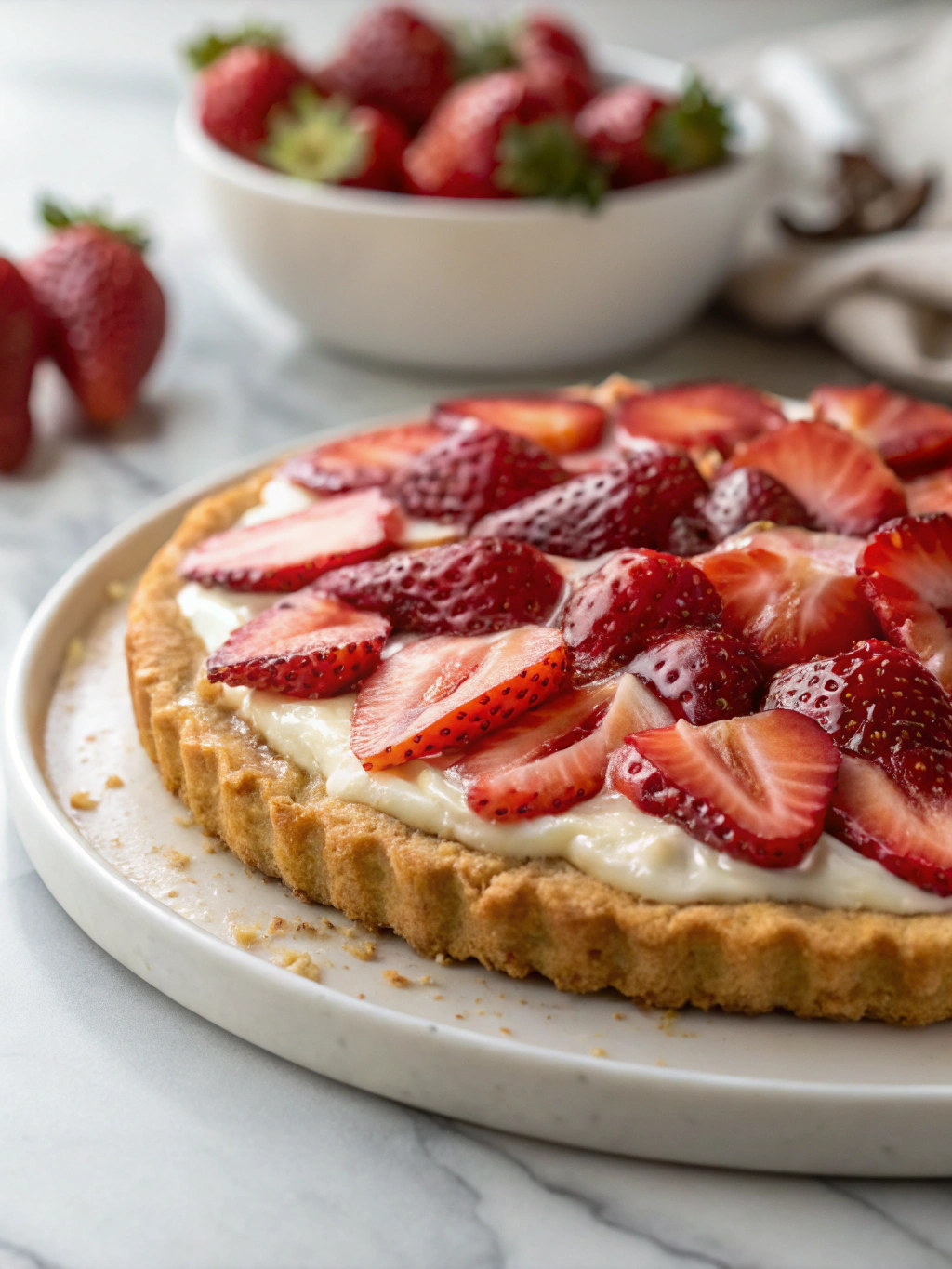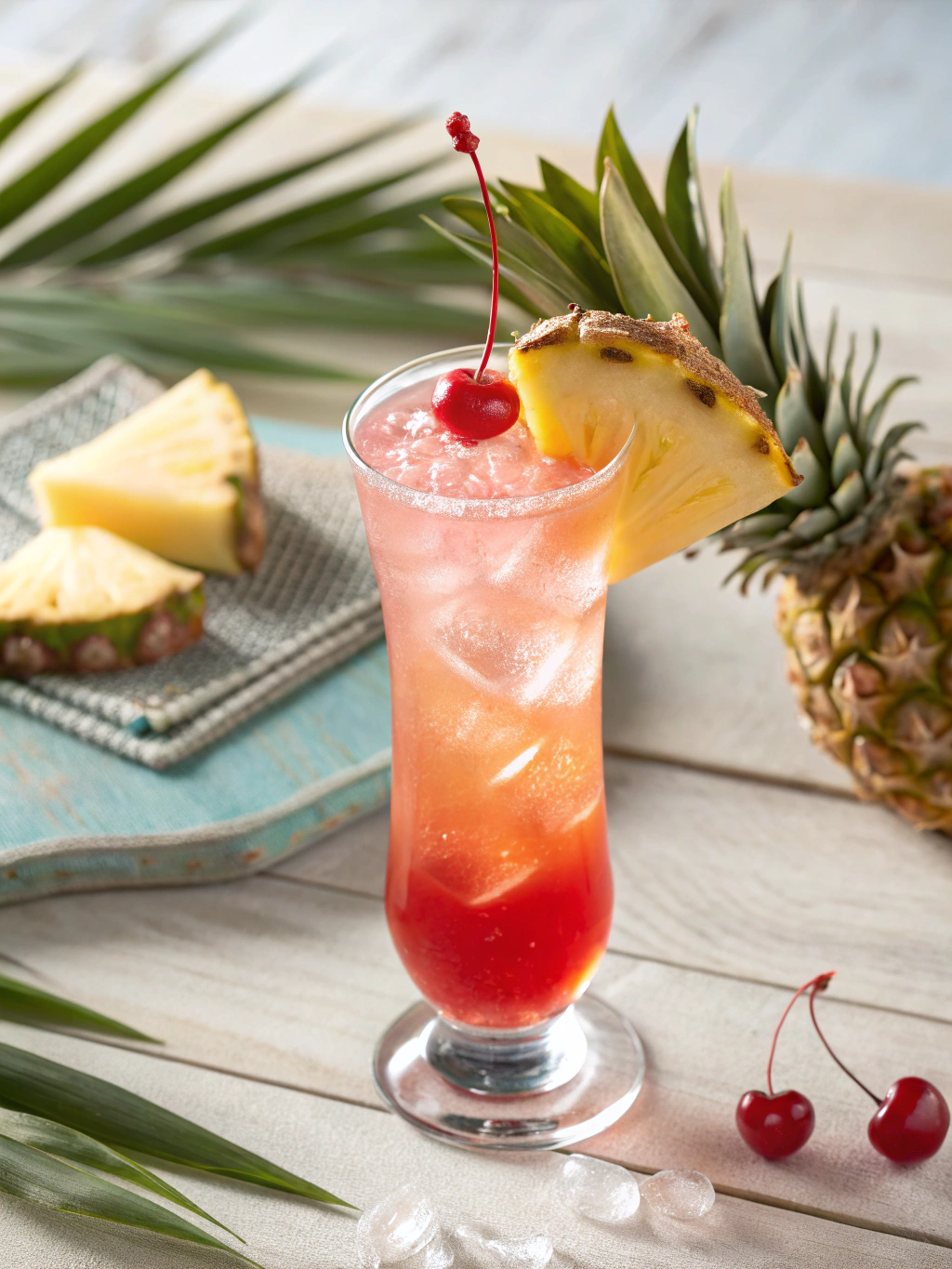Luscious Lemon Blueberry Cheesecake: A Citrusy Delight
Begin a delicious journey with our Luscious Lemon Blueberry Cheesecake, a treat that blends the zesty essence of lemon with the sweet burst of blueberries. This cheesecake is a dream dessert, perfect for any occasion, with its creamy texture and refreshing flavor. From the first bite, the tang of lemon envelops your taste buds, balanced perfectly by the sweetness of blueberries. The bright yellow of the lemon combined with the deep blue of the berries creates an appealing visual feast that is sure to mesmerize.
Quick Recipe Highlights
- Flavor Profile: The tangy lemon flavor offsets the blueberry sweetness, resulting in a delightful balance of tart and sweet.
- Texture: A buttery crust combined with a creamy cheesecake center and a smooth blueberry topping.
- Aroma: Freshly grated lemon zest adds a refreshing and fragrant citrus aroma.
- Visual Appeal: Beautiful contrast of vibrant yellow and blue, garnished with fresh berries.
- Skill Level Needed: Perfect for bakers with some experience, as it requires attention to detail in the cheesecake baking process.
- Special Equipment: A springform pan and an electric mixer are essential for the perfect consistency.
Recipe Overview
- Difficulty Level: This recipe is rated as intermediate due to the need for multiple processes, such as preparing the crust, mixing the filling, and ensuring a perfect bake without cracks.
- Category: Desserts, specifically cheesecakes.
- Cuisine: A fusion of American comfort food with a touch of French elegance in presentation.
- Cost: Moderately priced, with critical ingredients like cream cheese and fresh berries contributing to the cost.
- Season: Best enjoyed in the spring and summer when blueberries and lemons are in season.
- Occasion: Ideal for special occasions and celebrations, from birthdays to garden parties.
Why You’ll Love This Recipe
This Luscious Lemon Blueberry Cheesecake offers a perfect balance of creamy richness with a zesty twist, making it a must-try dessert. Its detailed process and variety of flavors appeal to both seasoned bakers and dessert aficionados seeking a fresh, new take on classic cheesecake.
Enjoy the convenience this recipe provides, with simple steps laid out to streamline your baking experience. The blend of easily available ingredients makes it uncomplicated yet rewarding, perfect for a weekend baking project.
Nutritionally, the featured fruits offer a dose of vitamin C and antioxidants, adding a slight guilt-free edge to your sweet indulgence. The richness from cheese provides calcium and protein, contributing to its dietary appeal.
Share this cheesecake as a centerpiece at gatherings for a guaranteed crowd-pleaser. Its eye-catching presentation and delightful taste are perfect for social settings, leaving your guests asking for more.
Cost-wise, while ingredients like fresh berries might be slightly pricy, their impact on the final taste justifies every penny, offering a homemade masterpiece that would command high prices in a bakery.
Historical Background and Cultural Significance
The origin of cheesecake dates back to Ancient Greece, where it’s believed to have been served during the first Olympics. The combination of cheese, honey, and flour made for a nutritious, energy-boosting snack.
Cheesecake has evolved over millennia, with each culture adding its unique twist. The American version with cream cheese originated in the 19th century, gaining widespread popularity due to its smooth texture and rich flavor.
Today, the recipe variations encompass a multitude of influences, with the lemon and blueberry combination offering a refreshing, modern take on the traditional dessert. Regional adaptations introduce elements like seasonal fruits or unique crusts to fit local tastes.
Ingredient Deep Dive
Lemons bring vibrant acidity and brightness to this cheesecake. Historically known for their health benefits, lemons are rich in vitamin C and antioxidants, contributing to immune support and skin health. When selecting, opt for firm, heavy lemons with thin skin for optimal juice yield. To store, keep in the fridge for up to a month to maintain freshness. Substitute lime for a different citrus twist if needed.
Blueberries are a superfood packed with vitamins K and C, fiber, and antioxidants. Select plump, firm berries without wrinkles, and store them in a breathable container in the fridge for up to a week. Frozen blueberries can be swapped in if fresh ones are out of season, although fresh berries deliver the best texture and flavor.
Common Mistakes to Avoid
- Overmixing the batter can incorporate too much air, leading to cracks. Mix on low speed until just combined.
- Using cold ingredients can affect texture. Ensure all components like cream cheese are at room temperature for smooth blending.
- Baking at too high a temperature can cause the cheesecake to puff and crack. A low, even heat helps maintain texture.
- Skipping the water bath step can lead to uneven cooking. The water bath provides a moist environment, preventing cracks.
- Not letting the cheesecake cool gradually can result in a deflated center. Allow it to cool in the oven with the door slightly open before transferring it to a wire rack.
- Forgetting to line the pan can cause sticking. Always line the bottom with parchment paper for easy release.
- Cutting too quickly can ruin the delicate texture. Chill thoroughly for clean slices.
- Neglecting to taste and adjust the lemon amount as desired; acidity levels in lemons vary greatly.
Essential Techniques
Baking the cheesecake in a water bath is crucial for achieving a creamy texture without cracks. This technique moderates the temperature, allowing the cheesecake to cook evenly. Master it by wrapping the outside of the springform pan with foil to prevent water from seeping in and placing it into a larger pan filled with water.
Pay attention to the consistency of the batter, which should be thick enough to hold up on a spoon but smooth and free of lumps. Achieving this requires gentle mixing, ideally with a paddle attachment at a low speed.
Pro Tips for Perfect Luscious Lemon Blueberry Cheesecake
To enhance the blueberry topping, simmer fresh berries with a pinch of sugar and a squeeze of lemon juice until they burst—this adds an extra layer of flavor and texture.
Allow the cheesecake to rest in the fridge overnight; this develops a more profound flavor and firmer texture, making it easier to slice.
A quick pass of a knife cleaned with warm water between cuts will yield perfect slices every time, maintaining the structural integrity of the cheesecake and toppings.
For an intensified lemon flavor, add finely grated lemon zest to the crust before baking to infuse the entire cheesecake with citrus notes.
Adapt the blueberry topping with seasonal fruits like raspberries or strawberries for a fresh, unique twist that suits the time of year.
Ensure your springform pan is tightly sealed when using a water bath to avoid any leakage, enhancing the smoothness of your bake.
Protect against cracking by letting the cheesecake gradually cool in the oven with the door slightly ajar, allowing the cheesecake to settle slowly.
If the top does crack, cover it entirely with the blueberry topping for a perfect finish that also boosts the presentation.
Variations and Adaptations
Try a regional twist by incorporating local berries or seasonal fruits into the topping, which allows you to enjoy this dessert year-round with differing fresh, fruity notes depending on what’s available.
For a lighter, summer variation, incorporate whipped cream into the cheese mixture, creating a more airy texture. This adjustment suits warmer climates or light dessert preferences after heavy meals.
Optimize the recipe for different dietary needs by using gluten-free cookies for the crust or dairy-free alternatives like coconut cream for a varied take.
Explore flavor variations with herbal infusions such as fresh basil or mint in the berry topping for a sophisticated touch that accentuates both the visual and taste profile of this cheesecake.
For a different textural experience, consider adding a layer of whipped cream cheese between the crust and cheesecake filling, offering a new depth of creaminess.
Presentation alternatives could include individual minis made in muffin tins for personal-sized treats, allowing customization for each guest’s preference.
Serving and Presentation Guide
To plate this cheesecake beautifully, use a flat offset spatula to remove slices cleanly from the springform base, placing them gently on dessert plates.
For garnishing, consider a light dusting of powdered sugar over the fruit topping, adding an elegant and professional touch.
Traditional accompaniments like a dollop of whipped cream provide a classic contrast to the rich cheesecake, encouraging a divine pairing with the fruity top.
Modern serving suggestions include pairing the cheesecake with a fresh basil or mint sprig, adding an aromatic component that uplifts each slice.
Serve chilled to maintain the cheesecake’s creamy consistency, enhancing the lush sensation as it melts in your mouth.
Focus on portion control by serving small slices, allowing guests to savor the rich flavors without overwhelming their palate, perfect for an impressive presentation at parties.
Wine and Beverage Pairing
Pair this Luscious Lemon Blueberry Cheesecake with a crisp, sweet wine such as a Moscato or Riesling, capturing the lemon notes and enhancing the fruit’s natural sweetness.
For non-alcoholic alternatives, consider a homemade lemonade with fresh mint, which complements the cheesecake’s refreshing lemon-tart flavors beautifully.
Coffee or robust tea like Earl Grey can also provide a bold contrast, while the bergamot notes particularly blend well with the citrus hints in the cheesecake.
It’s crucial to serve the chosen beverage or wine chilled, mirroring the cheesecake’s refreshing qualities, ensuring a cohesive drinking and eating experience.
Serve your chosen drink in clear glasses to reflect its color and complement the cheesecake’s vibrant presentation, maintaining coherence between food and drink.
Storage and Shelf Life
To store your cheesecake, wrap it tightly in plastic wrap and keep it in the refrigerator for up to five days, maintaining its fresh flavor and creamy texture.
Ensure it remains chilled consistently, as exposure to varying temperatures can affect the finish and flavor balance over time.
Use an airtight container if storing slices individually, perfect for optimal freshness when enjoying leftovers or portioned meals.
Look for any signs of spoilage, such as sour odors or discoloration, before serving leftovers; these suggest the cheesecake is past its peak freshness.
To reheat, bring slices to room temperature before serving, which develops the full complexity of flavors without compromising texture by reheating directly.
Freezing guidelines allow the cheesecake to be kept for up to three months; ensure proper wrapping and thaw slowly in the fridge overnight to retain quality.
Make Ahead Strategies
Prepare the crust and filling a day ahead, allowing the flavors to meld and reducing stress on the day of serving.
Store components separately if not assembling immediately, maintaining texture and preventing sogginess by wrapping the crust in cling film.
Evaluate quality by tasting all elements after resting, ensuring consistent flavor as time can deepen or alter certain aspects.
When assembling, spread any fruit topping just before serving to maintain a fresh, glossy finish, essential for the final presentation.
Reheat slices slightly just to remove the chill, ensuring a smooth texture without changing the structural integrity of the cake.
Add freshly cut lemon slices or zest prior to serving for a vibrant, aromatic lift that showcases the cheesecake ingredients’ freshness.
Scaling Instructions
To halve the recipe, adjust all ingredients proportionately, taking particular care with egg size or volumes, requiring careful measurement for consistency.
Doubling or tripling requires larger equipment, such as a bigger mixing bowl or larger capacity pan, to maintain thorough mixing and an even finish.
Timing might require adjustments; check for doneness frequently as larger bakes may extend the suggested cook time based on the cheesecake’s center set.
Scaling down requires smaller pan sizes, ideally maintaining similar shape characteristics to ensure even cooking and texture integrity.
Consider storage for larger batch productions by pre-slicing and separating with parchment, perfect for access when storing slices individually.
Nutritional Deep Dive
This cheesecake provides a breakdown of macronutrients, with each slice offering a balanced portion of fats from cream cheese, proteins, and carbohydrates for energy.
Micronutrient contributions, notably vitamin C from lemons and antioxidants from blueberries, provide additional health benefits, supporting overall well-being.
Portion control is key, with recommended serving sizes pitched to balance indulgence with nutrient needs, perfect for fitting within dietary guidelines.
Weight management tips involve accounting for cheesecake as part of a balanced meal, treating it as an occasional treat or shared dessert to moderate intake.
Dietary Adaptations
For a gluten-free version, opt for a crust made from gluten-free biscuits, ensuring accessibility without compromising on taste or texture.
A dairy-free option involves using plant-based cream cheese and coconut cream, presenting a vegan-friendly choice that still offers the traditional richness associated with cheesecake.
Low-carb alternatives can substitute the crust with almond flour and use sweeteners like stevia, maintaining the cheesecake’s essence without the carb load.
Keto adaptations can focus on high-fat ingredients, enhancing the indulgent quality while meeting keto guidelines for carbohydrate limits.
Paleo and Whole30 options involve using natural sweeteners and omitting processed dairy, aligning with structured dietary principles without losing the enjoyable dessert aspect.
For other specific diets, such as vegetarian preferences, this recipe already aligns naturally, making it a versatile option for diverse dietary needs.
The Recipe
Luscious Lemon Blueberry Cheesecake
Serves: 12
Prep Time: 30 mins
Cook Time: 60 mins
Total Time: 90 mins
Kitchen Equipment Needed
- Springform pan
- Electric mixer
- Mixing bowls
- Measuring cups and spoons
- Silicone spatula
- Offset spatula
- Baking sheet
- Foil for water bath
Ingredients
- 2 cups graham cracker crumbs
- 1/2 cup unsalted butter, melted
- 4 (8 oz) packages cream cheese, softened
- 1 cup granulated sugar
- 1/2 cup sour cream
- Juice and zest of 2 lemons
- 1 tsp vanilla extract
- 4 large eggs
- 1 cup fresh blueberries
- 1/4 cup sugar (for blueberry topping)
- 1 tbsp lemon juice (for blueberry topping)
Directions
- Preheat oven to 325°F (163°C). Prepare a springform pan by lining the bottom with parchment paper.
- In a bowl, mix graham cracker crumbs and melted butter, pressing evenly into the prepared pan to form the crust. Bake for 10 minutes, then cool.
- In a large mixing bowl, beat cream cheese until smooth and creamy. Add sugar and mix until combined.
- Mix in sour cream, lemon juice, lemon zest, and vanilla extract.
- Add eggs one at a time, beating on low speed until just incorporated. Pour the filling over the cooled crust.
- Wrap the bottom of the springform pan with foil and place it into a larger baking pan. Fill the larger pan with hot water halfway up the sides of the springform.
- Bake for 55-60 minutes, or until the center is just set and jiggles slightly. Cool in the oven with the door ajar for an hour.
- Meanwhile, make the blueberry topping by simmering blueberries, sugar, and lemon juice over medium heat until berries burst and thicken. Cool.
- Refrigerate the cheesecake for at least 4 hours, preferably overnight. Spread the blueberry topping over the chilled cheesecake before serving.
Recipe Notes
- For a firmer texture, allow the cheesecake to cool in the fridge overnight before serving.
- Customize with different berry toppings or a citrus-infused glaze for an exotic twist.
Troubleshooting Guide
If you encounter texture issues like cracks, ensure that you use a water bath and let the cheesecake cool slowly in the oven before removing it.
Flavor balance problems, like excessive tartness, can be adjusted by increasing sugar slightly or adding sweeter fruits to the mixture.
For temperature challenges, verify your oven calibration to maintain an even baking environment; cracked tops often indicate too high heat.
Equipment challenges often arise from improper sealing of the springform pan; check your foil wrapping method to maintain the water bath effect.
If substituting ingredients, such as gelatin for structural support, test smaller batches first, assessing the impact on texture and flavor before committing fully.
Address timing concerns by watching the cheesecake near the end of cooking; the center should be slightly jiggly but set to avoid over-baking.
Recipe Success Stories
Community feedback highlights successes with this cheesecake’s flavor, often mentioning its vibrant palate that captures the spirit of spring and summer thanks to fresh lemon and blueberry pairings.
Bakers globally have shared variation successes, whether incorporating wild berries from their locale or even enhancing the lemon profile by adding more zest.
Reader suggestions often add sophisticated touches like an herbal infusion or a decorative lemon wheel topping, bringing further elegance to this already captivating dessert.
Photography tips suggest natural lighting and ample garnish to highlight the cheesecake’s visual appeal, making it a photogenic star of any gathering.
Adaptation stories illustrate how this versatile recipe becomes a canvas for experimentation, from low-carb versions to full-bodied, creamy creations by tweaking key ingredients.
Frequently Asked Questions
Can I use frozen blueberries?
Yes, frozen blueberries can be substituted if fresh ones are unavailable. Simply thaw them and pat dry before use to ensure they blend well in the topping.
What if I don’t have a springform pan?
While a springform pan is ideal for cheesecakes due to its easy-release feature, improvising with a regular round cake pan can work if you line it well with parchment for easy removal.
How can I make this recipe vegan?
For a vegan adaptation, replace cream cheese and sour cream with their plant-based counterparts like cashew cream or coconut yogurt, ensuring to maintain the creamy texture and tang.
Why did my cheesecake crack?
Cracking can result from over-mixing, which incorporates too much air, or baking at a high temperature. Using a water bath and allowing gradual cooling helps control this issue.
Can I use a different type of crust?
Absolutely, feel free to experiment with different crusts such as cookie, nut-based, or a gluten-free alternative, each adding distinct textures and flavors to your cheesecake.
How long should I let the cheesecake cool?
After baking, the cheesecake should cool in the turned-off oven for an hour before moving it to the fridge to chill completely, ideally overnight for best texture.
What can I do if my batter is lumpy?
Lumps often occur if ingredients aren’t at room temperature. Ensure thorough mixing on low speed and consider straining out lumps if they’re persistent before baking.
Do I have to use the water bath method?
While not strictly necessary, the water bath is highly recommended for a smooth, crack-free surface due to its gentle cooking method.
How to determine doneness without a jiggle test?
If you’re uncertain, a simple toothpick or knife test inserted near the center, that comes out clean can also indicate that your cheesecake has cooked evenly.
How to store uneaten slices?
Place individual slices in airtight containers with parchment between layers to avoid sticking, refrigerate promptly, and consume within five days for best results.
Additional Resources
Explore related recipes like a tangy lemon tart or refreshing blueberry sorbet for more citrusy dessert inspiration, perfect for complementing this cheesecake in a dessert buffet setting.
Delve into technique guides such as mastering the water bath or perfecting the art of fresh fruit toppings, expanding your repertoire and skills.
Deepen your understanding of ingredient information with articles on the benefits of fresh versus frozen berries or insights into selecting premium cream cheese for rich, flavorful results.
For equipment recommendations, consider exploring non-stick pans or digital measuring scales to improve precision and ease of use in baking.
Seasonal variations can range from a summer berry fromage frais to a winter spiced orange cheesecake, adapting your approach to suit seasonal produce in any setting.
Join the Conversation
Share your results on social media using #LemonBlueberryCheesecake, inviting friends and followers to experience your version of this delightful dessert.
Photography enthusiasts can share tips on capturing the vibrancy of this cheesecake through lens choice and lighting, improving the presentation of your culinary creations.
Leave a review of the recipe, detailing personal adaptations and experiences that could inspire others to undertake this baking adventure.
Engage with the community by participating in baking challenges or themed events, connecting over a shared love of crafting and enjoying desserts like this cheesecake.
Experiment with variations and share your successes, offering a platform for creative expression and collaborative refinement of this classic recipe.

